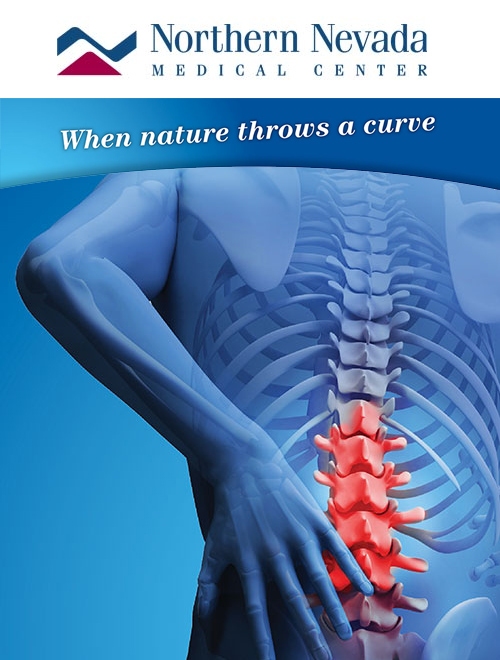Northern Nevada Medical Center
Living Well Online Summer 2015
Northern Nevada Medical Center offers nonoperative as well as surgical treatment for adult scoliosis.
 Adult scoliosis, an abnormal curvature of the spine with no known cause, usually begins in the teenage years and can progress as a person grows. Symptoms include shoulder unevenness or a lump in the lower back on the side of the curvature. Sometimes, a brace is worn when the abnormality appears, but if there are no disabling symptoms, scoliosis is often managed simply with observation and over-the-counter pain relievers. With aging, the curvature can get worse as the discs in the back settle, causing the person to lean progressively forward. If arthritis sets in and bone spurs form, the condition can be aggravated by weakness and pain.
Adult scoliosis, an abnormal curvature of the spine with no known cause, usually begins in the teenage years and can progress as a person grows. Symptoms include shoulder unevenness or a lump in the lower back on the side of the curvature. Sometimes, a brace is worn when the abnormality appears, but if there are no disabling symptoms, scoliosis is often managed simply with observation and over-the-counter pain relievers. With aging, the curvature can get worse as the discs in the back settle, causing the person to lean progressively forward. If arthritis sets in and bone spurs form, the condition can be aggravated by weakness and pain.
“There’s a spectrum of physical effects, ranging from hardly any curvature to curvature in two directions, which comes with disabling back and/or leg pain and spinal imbalance,” says neurosurgeon Deven Khosla, MD, with Northern Nevada Medical Center. He explains that a decision about treatment for adult scoliosis is based on factors such as age, bone density, other medical conditions and family support. “We first try all reasonable nonsurgical measures,” he says, possibly including exercise, physical therapy, injections, acupuncture, chiropractic treatments and massage therapy.
When surgery is necessary, Dr. Khosla customizes it for each individual patient. The operation can encompass procedures from fusion and stabilization of the spinal segments to removal of parts of the spine followed by realignment. Recent advances in surgical techniques have enabled smaller incisions for faster healing, and computer assisted surgical navigation that contributes to improved precision. For fusion and stabilization, Dr. Khosla is one of the few surgeons in the region to use the CD Horizon® Legacy™ PEEK Rod, a device that can replicate the natural load distribution of the lumbar spine.
“Natural load-bearing behavior of the spine helps the muscles recover and reduces long-term stress on the points where the rod is screwed to the bone,” says Dr. Khosla. “Early experience indicates that, because of its distribution ability, the PEEK Rod also lessens degeneration of adjacent areas of the spine.” Dr. Khosla says, regardless of the technology or the approach taken to treat adult scoliosis, “The baseline goal of what we do is to improve quality of life.”
